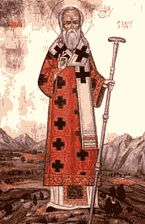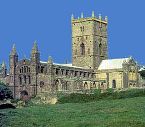David, the Patron Saint of Wales
- Published in Traditions, Folklore and History
Biography of St David / Legends and Miracles / Pilgrimage to St Davids / St David's Day
Wales’ National Apostle Saint David, or Dewi Sant, as he is known in the Welsh language, is the patron saint of Wales. He was the only Welsh saint to be canonised and culted in the Christian Church.
Saint David, or Dewi Sant, as he is known in the Welsh language, is the patron saint of Wales. He was the only Welsh saint to be canonised and culted in the Christian Church.
David came from an aristocratic family in Wales and was at the heart of the Welsh church in the 6th century. He became the abbot and biship of St Davids and died on 1st March 589 AD. He is buried in St David's Cathedral, Pembrokeshire. So respected was he that medieval pilgrims believed that two pilgrimages to St Davids were worth one pilgrimage to Rome.
March 1st, St David's Day, is now celebrated by Welsh people all over the world by wearing either of the national emblems - a leek or a daffodil.
The Life of Saint David - Biography
Almost all of the information we have about Saint David is based on the Vita Davidis biography (The life of St David), written by Welsh monk Rhygyfarch around 1094, five centuries after David's death.
Saint David is thought to have been born around 520 AD near the present town of St Davids. Some accounts say that his mother, Saint Non or Nonna, the granddaughter of king Brychan, was living as a nun when she was raped by a local chieftain. From this union was born a son, David, who was raised in her convent during his early childhood. Saint Non spent the later years of her life in a convent in Brittany and later became the patron Saint of the sexually assaulted.
David was ordained a priest and later studied under St Paulinus, a disciple of St Germanus of Auxerre. St Germanus was also the professor of the Irish Saint Patrick. David soon became renowned as a preacher and helped to spread Christianity among the Celtic tribes of western Britannia, founding many churches and monasteries.
David rose to abbot and bishop, presided over two synods, and went on pilgrimage to Jerusalem and Rome. He was active in fighting against the Pelagian heresy and he is said to have called the council that put an end to Pelagianism (Pelagius was a Briton monk who denied the Catholic doctrine of original sin). Saint David's most famous foundation was the monastery of Menevia, in the Welsh Land's End -now called St Davids-, where he remained until his death on 1st March 589.
Saint David: Legends and Miracles Many legends recount how the leek came to be the national emblem of Wales. One popular legend states that Saint David advised the Britons on the eve of a battle with the Saxons, to wear leeks in their caps so as to easily distinguish friend from foe. This helped secure a great victory. It is also believed that the same thing happened when Welsh archers fought with Henry V at the Battle of Agincourt in 1415. Hence the wearing of leeks and the tradition in many parts of Wales to drink leek broth on St David's Day.
Many legends recount how the leek came to be the national emblem of Wales. One popular legend states that Saint David advised the Britons on the eve of a battle with the Saxons, to wear leeks in their caps so as to easily distinguish friend from foe. This helped secure a great victory. It is also believed that the same thing happened when Welsh archers fought with Henry V at the Battle of Agincourt in 1415. Hence the wearing of leeks and the tradition in many parts of Wales to drink leek broth on St David's Day.
Saint David is also known, in Welsh, as Dewi Ddyfrwr or David the Water Drinker. It is claimed that he ate only one meal a day of bread with vegetables and salt, and he was known for long fasts during which he drank nothing but water for several days. Indeed, water was an important part of David's life: by the 9th century he had gained the nickname Aquaticus and of his missionary work it is said that "He opened many fountains in dry places.”
However, the most famous miracle associated with St David is said to have taken place on an occasion when he was preaching to a large crowd and the ground on which he stood rose up so that everyone had a better chance of hearing him. The miracle is said to have taken place at the village of Llanddewi Brefi.
Pilgrimage to St Davids David died at his monastery in Menevia on 1st March 589 and his body was buried in what is today St David's Cathedral. During the 10th and 11th centuries Menevia was regularly raided and vandalised by Vikings arriving from the western seaways. A visitor in the 11th century found only an abandoned site with St David's shrine lost amongst the undergrowth.
David died at his monastery in Menevia on 1st March 589 and his body was buried in what is today St David's Cathedral. During the 10th and 11th centuries Menevia was regularly raided and vandalised by Vikings arriving from the western seaways. A visitor in the 11th century found only an abandoned site with St David's shrine lost amongst the undergrowth.
After the Viking Age, St David's shrine became again an important place of pilgrimage; St David's Cathedral was built from 1115 around the Norman church of the monastery and Pope Callixtus II canonised David as a Saint in 1120. David's holiness was such that Pope Calixtus II announced that two pilgrimages to St Davids was equal to one to Rome, and that three pilgrimages to St Davids equalled one to Jerusalem.
Pilgrims came in their thousands to St Davids, which grew as a city around Saint David's Cathedral. Among those pilgrims were the Norman king William the Conqueror, who travelled to St. Davids soon after the Battle of Hastings, the Welsh kings Rhys ap Tewdwr and Gruffudd ap Cynan, and the English kings Henry II and Edward I.
By this time Saint David had achieved the status of Patron Saint of Wales and so the town of St Davids became the religious capital of Wales. Saint David's Day, March 1st, was celebrated as a Holy Day up until the Reformation of the 16th century, when the Protestant Church won out over Roman Catholism and removed all traces of Catholic idolatry. Today, St Davids still gets thousands of 'pilgrims', this time in search of beautiful scenery and the great outdoors of the Welsh Land's End, the westernmost point of Wales.
Saint David and Wales' National Day
1st March, St David's Day (Dydd Gwyl Dewi Sant), is a national celebration of Welsh nationality and culture, and special celebrations are held all over Wales to commemorate the country's Patron Saint.
St David's Day usually means singing and eating. Concerts are held to mark the occasion and leeks are worn - and eaten. Many local festivities traditionally feature traditional Welsh dances, Welsh folk songs and Welsh poems. St David's Day is also one of the most important dates in any School in Wales, when pupils from primary and secondary schools dress in the traditional Welsh costumes and celebrate the Saint's day with an Eisteddfod, a festival of poetry, song and dance.
St David's Day has been a national festival in Wales since the 18th century, when the London Welsh societies started celebrating their St David's Day dinners. Today, St David’s Day is celebrated as a patriotic and cultural festival by the Welsh in Wales and throughout the world. However, contrary to Ireland's St Patrick or Galicia's St James, St David is not a public holiday in Wales. The debate whether St David's Day should be promoted as a Welsh bank holiday is still on.
Jean Pouliquen, February 2005
|
Do you want to know more about Saint David? |


